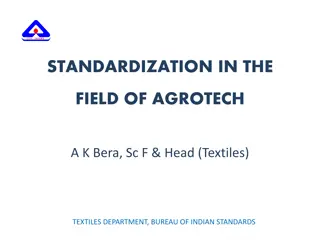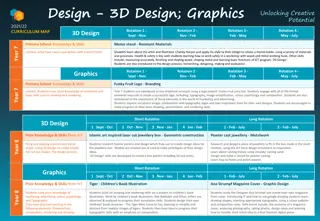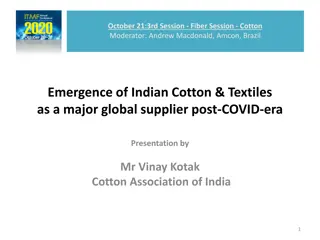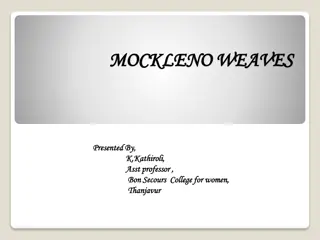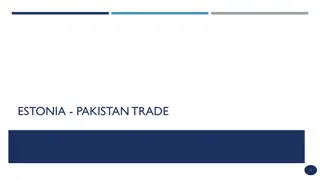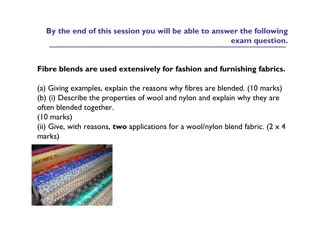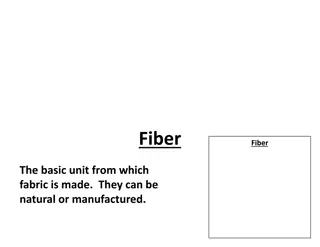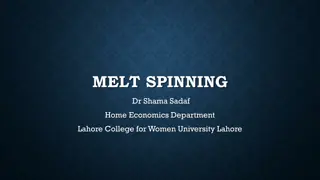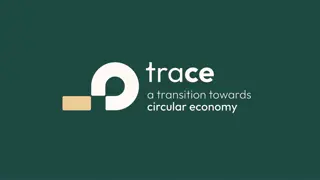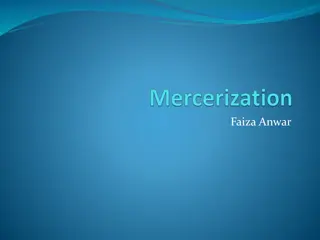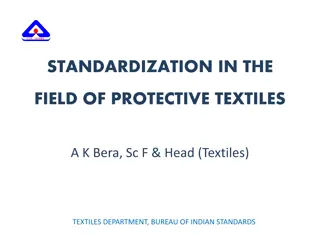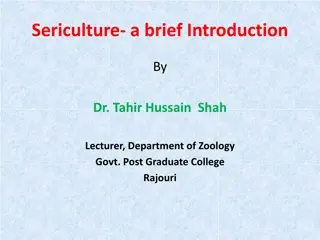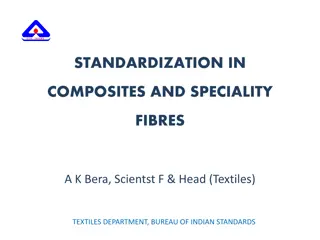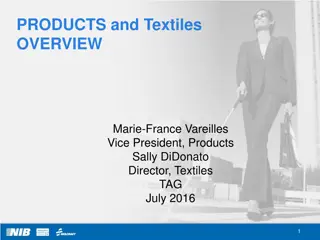The Growing Significance of Technical Textiles in Today's Industry
Technical textiles play a crucial role in various industries due to their high technical requirements and quality standards. They offer unique functions such as durability, cost-effectiveness, and eco-friendliness. From traditional to modern applications, technical textiles continue to evolve, meeting specific requirements with innovative materials and production techniques.
- Technical Textiles
- Industrial Textiles
- Functional Textiles
- Material Innovation
- Industry Transformation
Download Presentation

Please find below an Image/Link to download the presentation.
The content on the website is provided AS IS for your information and personal use only. It may not be sold, licensed, or shared on other websites without obtaining consent from the author. Download presentation by click this link. If you encounter any issues during the download, it is possible that the publisher has removed the file from their server.
E N D
Presentation Transcript
Technical Textiles: A Promising Future Technical Textile: A Promising Future
Broad Division of Textile Traditional textile, general textile General use, to improve aesthetic sense, for communication etc Technical textile, industrial textile, and functional textile to serve a particular and technical requirement
Historic Perspective of Technical Textile Before invention of synthetic fibres: Natural fibres were treated with chemicals to make it useful in some specific situations Nonwoven techniques were used to manufacture technical textile
Reasons of Technical Textile Growth 1. Health and safety 2. Cost effectiveness 3. Durability 4. High strength 5. Light weight 6. Versatility 7. Customisation 8. User friendliness 9. eco-friendliness 10. Logistical convenience, etc.
Technical Textile Synonymous Technical textiles Industrial textiles Functional textiles
Technical Textile by Definition Materials and products intended for end-uses other than non-protective clothing, household furnishing, and floor covering, where the fabric or fibrous component is selected principally but not exclusively for its performance and properties as opposed to its aesthetic or decorative characteristics (Textile Terms and Definitions, TI, Manchester, 10the Ed.).
Technical textiles are materials meeting high technical and quality requirements (mechanical, thermal, electrical, durability...) giving them the ability to offer technical functions. Encyclopedia Universalis
Production of Technical Textiles Application of certain chemicals ( water and fire proofing etc) Use of intelligent fibers (glass fiber, carbon fibers) Special technical in fabric formation (3 D weaving, Double layer knitting etc)
Seven Ways to Make Techinal Textiles Thermo-forming Three Dimensional Weaving Three Dimensional Knitting Fabrics Produced Using Nanotechnology Heat-set Synthetics Finishing Treatments such as Water-resistant Coatings & Holographic Laminates Hand-made elements such as Stitch or Appliqu (Tex.in ,2020)
Types of Technical Textiles 1. Mechanical functions (Mechanical resistance, Reinforcement of materials, Elasticity) 2. Exchange functions (Filtration, Insulation and conductivity, Drainage Impermeability, Absorption) 3. Functionalities for living beings (Antibacterial, Antirust, mites, Biocompatibility, Biodegradability/bioresorption) 4. Protective functions (Thermal, Fire, Mechanical, Chemicals, Impermeable, - Breathable, Antistatic Particles, antireleaseVicenza, Electrical insulation, IR and UV rays, NBC High visibility Electromagnetic fields .....) Nomez divides Technical textiles into main four classes based on their functions (Nomez)
1. 2. 3. 4. 5. 6. 7. 8. 9. 10. Clothtech 11. Buildtech 12. Hometech (Chakrabarty) Mobitech Meditech Sportech Protech Indutech Geotextiles Packtech Oekotech Agrotech
Application of Technical Textiles Aerospace applications Aquaculture Architecture Abrasion-resistant materials Absorbent materials Adhesive materials Agriculture Anti ballistic materials Anti magnetic materials Anti static materials Auxetic materials
Conti Bedding materials Biodegradable materials Biomaterials Building materials Cleansing materials Composites High performance clothing Computing industry high performance materials Cut-resistant materials Deodorizing materials Elastic materials Electrical and electronic industries Environment
Conti Filtration materials Fire-resistant materials Flooring textiles Furnishings Geosynthetics and geotextiles Hygiene materials Insulating materials Leisure Lines and ropes Luggage Luminescent and reflective materials Marine industry materials Medicine
Conti Medical clothing Therapeutic clothing Surgical clothing Anti allergy materials Anti bacterial materials Anti microbial materials, Anti radiation materials Wound dressings & bandages Prostheses Orthopaedics materials Dental industry Military applications Nanotechnology Packaging Phase change materials
Conti Safety Protective and safety clothing Sails and tenting Shape memory materials Smart textiles Soluble materials Sports Sports goods Substrates
Conti Therapeutic materials Thermal materials Transportation Automotive Waterproof materials Windproof materials
Market of Technical Textiles Double Incentive Scheme for Technical textiles (China) Bundle of relief package for the promotion of technical textiles in the country (India) (Memon and Zaman In India US$ 6.25 billion budget for Technology Up gradation Fund Scheme (Mittal).
Market Size Market size increase by 3.5% per annum between 1995 and 2005 3.8% per annum from 2005 to 2010 In volume terms, to reach 23.8 MT With a value of $126 Billion by 2010 (Czajka, 2005)
Market Annual Share (%) Growth (%) Industry Transport Medical Construction Agriculture Civil Engineering Sports and Leisure Protection 21 20 16 10 8 3 2 2 3.9 2.8 1.5 2.9 1.2 5.7 3.3 5.7
A Few Modern Examples Breathable Synthetic Fabrics Some Synthetic Fibers are Ultra-lightweight & High-stretch, some are thin & light-reflective, Some Hollow Fibers Trap Air to Retain Heat Natural Fibers Blended with Synthetics to Improve Strength, Crease Resistance & Easy Care Ultra Microfibers Using the latest in micro technology, scientists are building fabrics where the fiber itself is scrutinized and manipulated in minute detail. A microfiber is by definition a material in which the yarn s thickness is equal to or less than 1/60th the thickness of an average human hair. Ultra-microfibers on the market are even finer some having thickness of just 1/200th the thickness of human hair.
Fabrics that have relief surfaces and even three- dimensional (3-D) structure Metallic textiles fluid & shimmering materials Extreme Sportswear Polyamide (warp) and paper (weft) woven together and then hand silkscreen printed. This exquisite fabric, designed in a customized manner in Japan, is used for high-end interiors. Microfiber with metal foil spots combine to give a consistent metallic finish. This blend can be used for high-end fashion garments (especially outerwear)
Phase change materials incorporated in fabrics can absorb excess heat, store it, and gradually release it later. These are ideal for body temperature control. Fabrics with charcoal as a component can filter odour and pollution. Charcoal was used for its health-giving properties as it has the ability to absorb chemical impurities in the air. Microfibers engineered with substances suspended in minute bubbles that can be gradually released. These microcapsules can contain medication, vitamins, insect repellants, moisturizers, essential oils or perfumes...
E- Textiles Sports shoes Wearable computer jackets Warning vests Photonic textiles for innovative lighting solutions Wearable E-Health system Electronic Textiles to Help Battlefield Medics
Synergy Affect Combination of Stainless Steel Fiber with Cotton & Polyamide to create a soft & flexible cloth Combination of cotton, copper, polyamide, and polyurethane to create a metallic surface Light Emitting Diodes (LEDs) embedded in hand-woven linen, programmable, and controllable through sensors. These can be used in creative arts practice, sportswear, & medical use, as well as in interactive costumes for dance, theatre, and expressive gallery textiles. Metals & Papers in combination with silks & polyesters Layered weave structures made on computer-assisted looms allow for intricate constructions and reversibles
How You Can Enter Knowledge about the requirements of customer and matching production facilities Testing facility to test the product to ensure to meet the customer expectation and specifications Technical textile needs state of the art knowledge for production and testing. Currently developed countries have dominance in this market.
Way to Enter in This market: Cohesive effort by govt, academic and industry Testing facilities common.. Should be provided by govt Industry should have a liaison with academic and work on project to project Military, being the big user of technical textiles should come forward and encourage local industry to develop technical textiles Academia should make proposals and have a joint venture with industry A common degree in technical textiles should be offered by different universities Govt should offer special attractions for technical textiles, like China and India



